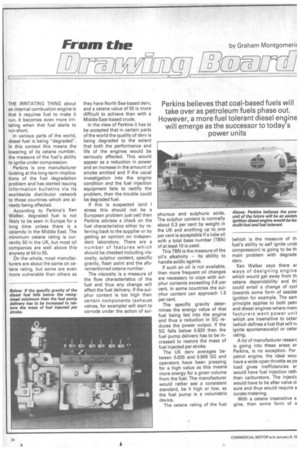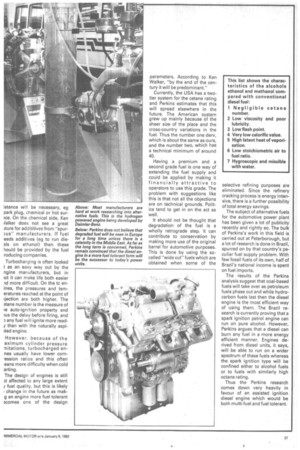Perkins believes that coal-based fuels will take over as petroleum
Page 30

Page 31

If you've noticed an error in this article please click here to report it so we can fix it.
fuels phase out. However, a more fuel tolerant diesel engine will emerge as the successor to today's power units
THE IRRITATING THING about an internal combustion engine is that it requires fuel to make it run. It becomes even more irritating when that fuel starts to run short.
In various parts of the world, diesel fuel is being "degraded". In this context this means the lowering of its cetane number, the measure of the fuel's ability to ignite under compression.
Perkins is one manufacturer looking at the long-term implications of the fuel degradation problem and has started issuing information bulletins via its worldwide distributor network to those countries which are already being affected.
According to Perkins's Ken Walker, degraded fuel is not likely to be seen in Europe for a long time unless there is a calamity in the Middle East. The minimum cetane rating is currently 50 in the UK, but most oil companies are well above this anyway at 54 to 55.
On the whole, most manufacturers are about the same on cetane rating, but some are even more vulnerable than others as they have North Sea-based derv, and a cetane value of 50 is more difficult to achieve than with a Middle East-based crude.
In the view of Perkins it has to be accepted that in certain parts of the world the quality of dery is being degraded to the extent that both the performance and life of the engines would be seriously affected. This would appear as a reduction in power and an increase in the amount of smoke emitted and if the usual investigation into the engine condition and the fuel injection equipment fails to rectify the problem, then the trouble could be degraded fuel.
If this is suspected (and I stress this should not be a European problem just yet) then Perkins advises a check on the fuel characteristics either by referring back to the supplier or by getting an opinion on independent laboratory. There are a number of features which should be checked including viscosity, sulphur content, specific gravity, flash point and the aforementioned cetane number.
The viscosity is a measure of the flow characteristics of the fuel and thus any change will affect the fuel delivery. If the sulphur content is too high then certain components (exhaust valves, for example) will start to corrode under the action of sul
phurous and sulphuric acids. The sulphur content is normally about 0.3 per cent by weight in the UK and anything up to one per cent is acceptable if a lube oil with a total base number (TBN) of at least 10 is used.
This TBN is the measure of the oil's alkalinity — its ability to handle acidic agents.
If such an oil is not available, then more frequent oil changes are necessary to cope with sulphur contents exceeding 0.6 per cent. In some countries the sulphur content can approach 1.5 per cent.
The specific gravity determines the energy value of that fuel being fed into the engine and thus a reduction in SG reduces the power output. If the SG falls below 0.820 then the fuel pump delivery has to be increased to restore the mass of fuel injected per stroke.
The UK dery averages between 0.835 and 0.845 SG and operators have been pressing for a high value as this means more energy for a given volume from the fuel. The manufacturer would rather see a consistent standard, be it high or low, as the fuel pump is a volumetric device.
The cetane rating of the fuel (which is the measure of th fuel's ability to self ignite uncle compression) is going to be th main problem with degrade derv.
Ken Walker says there ar ways of designing engine which would get away from th cetane dependability and thl could entail a change of cycl towards some form of assiste ignition for example. The sam principle applies to both petn and diesel engines where man' facturers want power unit which are insensitive to octar (which defines a fuel that will ni ignite spontaneously) or cetar rating.
A lot of manufacturer researc is going into these areas ar Perkins, is no exception. For petrol engine, the ideal wou have a wide-open throttle as pa load gives inefficiencies ar would have fuel injection rath than carburetors. The injectic would have to be after valve cl sure and thus would require a curate metering.
With a cetane insensitive e gine, then some form of a istance will be necessary, eg park plug, chemical or hot surice. On the chemical side, Ken lialker does not see a great iture for addititives from "spur)us" manufacturers. If fuel eeds additives (eg to run dieels on ethanol) then these hould be provided by the fuel roducing companies.
Turbocharging is often looked t as an easy way out by the ngine manufacturers, but in ict it can make life both easier -id more difficult. On the tc enines, the pressures and terneratures reached at the point of ijection are both higher. The Aerie number is the measure of )e auto-ignition property and tus the delay before firing, and 3 any fuel will ignite more ready than with the naturally aspiited engine.
However, because of the aximum cylinder pressure -nitations, turbocharged ennes usually have lower cornession ratios and this often eans more difficulty when cold arting.
The design of engines is still pt affected to any large extent y fuel quality, but this is likely I change in the future as makg an engine more fuel tolerant 9comes one of the design parameters. According to Ken Walker, "by the end of the century it will be predominant."
Currently, the USA has a twotier system for the cetane rating and Perkins estimates that this will spread elsewhere in the future. The American system grew up mainly because of the sheer size of the place and the cross-country variations in the fuel. Thus the number one derv, which is about the same as ours, and the number two, which has a technical minimum of around 40.
Having a premium and a second grade fuel is one way of extending the fuel supply and could be applied by making it financially attractive to operators to use this grade. The problem with suggestions like this is that not all the objections are on technical grounds. Politics tend to get in on the act as well.
It should not be thought that degradation of the fuel is a wholly retrograde step. It can contribute to conservation by making more use of the original barrel for automotive purposes. This is done by using the socalled "wide cut" fuels which are obtained when some of the selective refining purposes are eliminated. Since the refinery cracking process is energy intensive, there is a further possibility of total energy savings.
The subject of alternative fuels for the automotive power plant has been given a lot of publicity recently and rightly so. The bulk of Perkins's work in this field is carried out at Peterborough, but a lot of research is done in Brazil, spurred on by that country's peculiar fuel supply problem. With few fossil fuels of its own, half of Brazil's national income is spent on fuel imports.
The results of the Perkins analysis suggest that coal-based fuels will take over as petroleum fuels phase out and while hydrocarbon fuels last then the diesel engine is the most efficient way of using them. The Brazil research is currently proving that a spark ignition petrol engine can run on pure alcohol. However, Perkins argues that a diesel can burn any fuel in a more energy efficient manner. Engines derived from diesel units, it says, will be able to run on a wider spectrum of these fuels whereas the spark ignition type will be confined either to alcohol fuels or to fuels with similarly high octane rating.
Thus the Perkins research comes down very heavily in favour of an assisted ignition diesel engine which would be both multi-fuel and fuel tolerant.










































